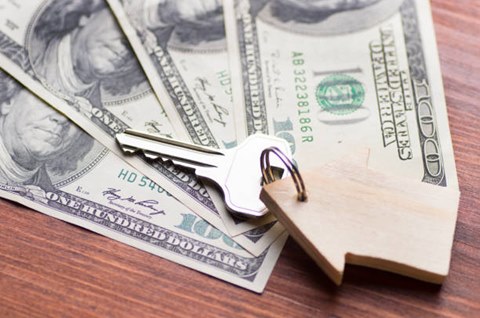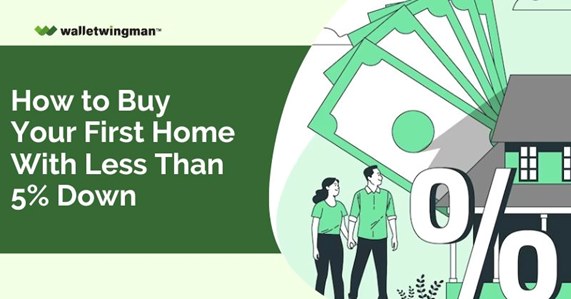First-time home buyers face several obstacles in becoming homeowners, from finding a property to comprehending the financing procedure.
The up-front costs of buying a house, especially the down payment, are one of the major obstacles. A first-time buyer, after all, does not have the funds from the sale of their former home to use toward their current purchase.
Instead, people frequently need to save money over time for a down payment.
That might not be as challenging as you think, though. In this post, we’ll look at different options for purchasing your first house with less than 5% down, including the possibility of no money down home purchase.
Misconceptions Relating to Down Payments

Let’s start by dispelling common myths and misconceptions surrounding down payments in the home-buying process.
When researching homeownership and mortgages, you’ve likely encountered discussions about the 20% down payment threshold. Despite the fact that there are alternatives to this typical criterion, such as no money down mortgages, many publications on house affordability use this 20% figure as an example.
Unfortunately, a lot of potential customers are not aware of these possibilities. A 20% down payment or more was considered to be essential by 10% of respondents to 2022 research by the National Association of REALTORS®, while 35% of respondents said a down payment of between 16% and 20% was necessary. This illustrates how widespread this misunderstanding is.
Let’s examine the many options accessible to first-time homebuyers interested in low or zero down payment home buying after dispelling this fallacy.
Buying Your First Home With Less Than 5% Down
In the summer of 2023, the average cost of a home in the US was close to $349,000. For a property in this price range, a 20% down payment would be close to $70,000. The typical first-time buyer may need several years to save up such a significant sum of money.
The good news is that there are doable strategies that can be implemented, making homeownership more attainable for people who may be asking how to save money to buy a house. Here are three practical ways for first-time homebuyers to get a mortgage with a down payment of under 5%.
FHA-Insured Loans: 3.5%

First-time buyers in the US prefer FHA loans because of their flexibility, especially when it comes to down payments.
The minimum amount for the down payment for an FHA loan for a first-time home buyer is 3.5% of the home’s appraised value or purchase price. To put this into perspective, go back to the last time a $70,000 down payment was required for a property with a median price. With an FHA loan, the required down payment is only 3.5%, bringing the initial cost down to about $12,000.
It’s important to remember that your exact down payment amount may vary depending on factors like the cost of the property. But when compared to a traditional mortgage, which requires a 20% down payment, these numbers show a significant decrease in the down payment.
Nevertheless, there’s a caveat – to qualify for the 3.5% down payment option with an FHA loan; first-time buyers should have a credit score of 580 or higher. Those with lower credit scores might be required to make a larger down payment. Consequently, if you’re considering this program for your first home purchase, it’s advisable to begin by checking and potentially improving your credit score.
Conventional Mortgage With PMI: As Low as 3%

A conventional home loan stands in contrast to government-backed or insured loan programs like FHA and VA loans. Essentially, it’s a standard mortgage without government backing.
The minimum required down payment for a conventional home loan can vary based on factors such as the loan amount, but many first-time homebuyers can qualify with just a 3% down payment.
Mortgages with a loan-to-value (LTV) ratio of up to 97% are accepted by government-sponsored companies Fannie Mae and Freddie Mac, which buy mortgage loans from lenders.
Here’s how Freddie Mac describes one of their loan programs:
“In addition to its down payment requirement of as little as 3%, Home Possible now offers more options to responsibly increase homeownership for more of your borrowers.”
However, one drawback of such low-down payments is the necessity of private mortgage insurance (PMI). Typically, conventional loans require PMI when the loan-to-value ratio exceeds 80%. This adds extra costs to monthly mortgage payments.
Yet, PMI offers a significant advantage for many first-time buyers by reducing the upfront investment required to purchase a home, which aligns with strategies on how to invest in real estate without buying property.
Without PMI, most conventional loan borrowers would need much larger down payments, potentially even the 20% industry standard. Thankfully, with a conventional loan and PMI, first-time buyers can secure their first homes with down payments below 5%.
VA Loans for Military Home Buyers: 0%

Last but certainly not least, we come to the VA loan program, which enables certain individuals to fulfill their dream of purchasing a home with no down payment. This beneficial program is available to most military members, veterans, and certain qualifying spouses.
One of its significant advantages is that by facilitating the purchase of a house without requiring any down payment, it enables first-time home buyers to seek options of how to buy a home with no money down.
Sure, you’ll probably still encounter closing costs, as you would with any other type of home loan. However, the ability to finance 100% of the price could help you buy a home with no money down within months instead of waiting years to save up for a down payment.
Conclusion
These are not the only home loan options available to first-time buyers. You have a vast selection of products and programs to pick from when it comes to mortgage finance.
In this article, we’ve focused on three ways a first-time buyer could purchase a house with less than 5%.
As you embark on your homebuying journey, it’s essential to explore the diverse array of products and programs available to suit your specific needs and financial situation, just as you would explore the best books on real estate investing to further educate yourself on the intricacies of the real estate market.



 10 Best Books on Real Estate Investing You Must Read In 2023
10 Best Books on Real Estate Investing You Must Read In 2023 